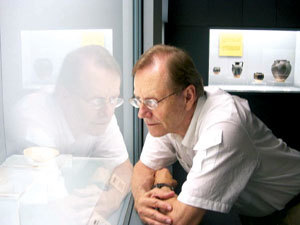fMRI Experiment on Art Creation, by Robert Solso
The late Robert Solso, the author of Cognition and the Visual Arts and The Psychology of Art and the Evolution of the Conscious Brain, conducted MRI scans of a portrait artist while making thirty-second drawings of faces inside the scanner. When the results were compared to those of a psychology graduate student with no formal art training, they revealed decreased activity in the artist’s fusiform face brain area (FFA), frequently associated with face identification, and increased activity in his right middle frontal area, usually associated with “more complex associations and manipulations of visual forms” (Solso 2000, 82).
The lower FFA level of activation indicated that the artist “may be more efficient” than the novice at processing facial features, and the involvement of the right frontal part of the brain suggested that he engaged in a “‘higher order’ interpretation” and an “abstracted representation” of the perceived face (83; also Solso 2001). What have we learned? A visual artist can be expected to be more efficient than a novice at processing visual stimuli, and morphological and physiological brain changes always accompany doing and learning.
Of course empirical details are important, and they may be useful to detect, diagnose, and treat any number of conditions attributable to a brain lesion. Art, however, is not in the brain as a lesion is in the brain, and the commonality neuroaestheticians claim to discover does not illuminate the differentiated aesthetic reactions individuals can have vis-à-vis a Mondrian and a Malevich: you can find the one beautiful and the other ugly even though perceiving both necessitates the firing of neurons specialized in straight lines. The fact that perceiving a Mondrian and a garden fence activates the same cells reveals nothing specifically about hedonic preference and even less about the aesthetic relation.


















0 comments
Sign in or create a free account